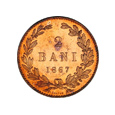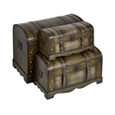Queen Marie`s Crown
Authors: Costin Petrescu & Falize Frères, Paris.
Texts: Dr. Ernest OBERLÄNDER-TÂRNOVEANU, Dr. Diana MANDACHE / Photo: Marius AMARIE, George NICA
The closed crown, with fleuron and an ellipsoidal base, is composed of a frontal band from which eight large fleuron develop in the shape of heraldic lily flowers and eight smaller ones, in clubs shape, made of gold plate. The lower part of the frontal band is decorated, using “au repouse” technique, with a frieze made of oblique disposed wheat grains, gathered two by two, enclosed by a triple frame, while the rest of it is covered by a frieze made of acanthus leaves and stylized barded stalks, strewed with mountings of semiprecious stones, turquoises and chrysoprases, cut and filed in cabochon shape.
The large fleuron continues through eight accolade beams, with rolled ends, that merge in the centre of the crown holding a cross-bearing orb, surmounted by a gammadion cross (or fylfot), and with 45° angled sides, supported on the right side by a golden pearl. The crown’s beams are adorned alternatively, in “au repouse” technique, with geometrical and vegetal stylized motifs. On its inner side the beams are welded with the fleuron from which they develop. These are attached in the centre around a circular shim with eight beams, on which is welded the cross-bearing orb. The surface of the gammadion cross is browned. In the temporal area, the crown has two pendants named pendilia or prependoulia, comprised by two circular frames, hanging from the base of the crown, with two bangles. In each frame is inscribed a rhomboid plate surrounded by a stylized vegetal adornment, realized by using the piercing technique and by semiprecious stones – opals , crysoprases and garnets, cut and filed in cabochon shape. The plate on the right (heraldic position), adorned with geometrical motifs, made by using “au repouse” technique, is stamped with a small shield, illustrating the small emblem of the Romanian Kingdom (the model used after 1919, enshrined by the Constitution of 1923), realized by engraving. The badge is weald to the plate. The heraldic plate from the left is stamped with a shield representing Queen Maria’s blazon as princess of Edinburg, princess of United Kingdom of Great Britain and Ireland, princess of Saxa-Cobourg-Gotha and duchess of Saxony, titles that she had had until 1893, when she married Ferdinand, the crown prince of Romania. This heraldic emblem is made by engraving technique. The two plates of the temporal pendants continues with three chains, two short and a long one in the centre, composed by bangles shaped as grains of wheat, fastened with small circular rings. Each chain has, in its origin point and in the middle one circular button with a cabochon onyx mounted in it. Both ties had a circular pendant at the ends, with a gammadion cross engraved in the middle, with 45° angle sides. The chains, same as the crosses engraved on the pendants are browned. The crown’s base consists of an ellipsoidal band, welded on the frontal plate, where is engraved an inscription written in French, with uncial letters: LES FRERES FALIZE/ ORFEVRES/ANCIENS JOAILLIERS/DE LA COURONNE. The words are crossed and separated by a complex stylized vegetal design. The crown has a burgundy velvet lining and a leather brim with six staples
Art and symbol: The Crown of Queen Marie of Romania
The crown of Queen Maria, ordered by the Romanian Parliament for the coronation ceremony that took place at Alba-Iulia, was manufactured in Paris by Falize jewellery house, using Transylvanian gold. This choice also had a symbolic aim. The Byzantine-style design, with vegetal motifs, was designed by Costin Petrescu, who was inspired by the crown of lady Despina-Milita (Neagoe Basarab’s wife). At the same time he made allowance for Queen Maria’s desire to give her appearance a medieval aura. Maria wanted to have her own coronation crown, inspired by the fact that in Great Britain, in the 20th century, for each queen-consort were designed new crowns, even though these incorporated an central element used before, usually a precious stone. For example, the crown of Queen Alexandra, from 1902, had, as a central element, the famous diamond “Koh-i-Noor”, ulterior used by Queen Mary in her new crown that she wore at the 1911 ceremonial, to which are added two new diamonds: the third and fourth star of Africa, cut from the well known Cullinan diamond. An unusual accessory of the crown is the pendilia. The combination of these characteristics with Byzantine elements suggested the continuity of the Romanian medieval states tradition. It is a unique join of royal symbols that expresses the new national identity acquired by the granddaughter of Queen Victoria. On the two medallions three chains are tied, representing grains of wheat, a symbol of fertility and of the sovereign’s bound with the country. At the end of each chain there was a gammadion cross, similar to that one from the top of the crown. The stylized gammadion cross is a representation of the ancient cosmic religious symbols that are often found in the Romanian ethnographic art. The choice of the stones that adorned the Queen’s crown was in accord with her romantic vision: the moon’s stone – opal, turquoise, amethyst, garnet, tourmaline, chrysoprase. According to the documents from the Falize archives, the order for the crown, made by the Parliament, represented by the President of Senate, General Coanda and by colonel Drosso, who represented king Ferdinad, was registered on 5th of August 1921. Although it should be delivered on January, 22, 1922, the cost being estimated between 45 and 50 thousands francs, it was delivered on 30 September, 30, 1922 at a higher price, 64 820 francs.
Today, the crown could be found in the Treasure room. Along with the gold crown, Queen Maria wore at the coronation, the famous Cartier diamond necklace and the well known sapphire as pendant. These were ordered by King Ferdinand at the jewellery house Cartier. Being satisfied with the creation of Falize House, the Queen has ordered a copy of the crown that is exposed to US Maryhill Museum. Compared to the original, the one from 1923 was made of golden silver not gold and instead of garnet it has rubies and the crysoprase was replaced with peridotite.




















